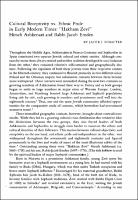Please use this identifier to cite or link to this item:
https://hdl.handle.net/20.500.12202/9058| Title: | Cultural receptivity vs. ethnic pride in early modern times: "Hakham Zevi" Hirsch Ashkenazi and Rabbi Jacob Emden |
| Authors: | Schacter, Jacob J. Hirschler, Gertrude |
| Keywords: | Ashkenazim Sephardim cultural cross-fertilization cultural objectivity comparative study of customs Franco-Germany Emden, Jacob, 1697-1776 Ashkenazi, Ẓevi Hirsch ben Jacob, -1718. |
| Issue Date: | 1988 |
| Publisher: | Yeshiva University Museum |
| Citation: | Schacter, J. J. (1988). Cultural receptivity vs. ethnic pride in early modern times: "Hakham Zevi" Hirsch Ashkenazi and Rabbi Jacob Emden (pp. 69-78). In G. Hirschler (Ed.), Ashkenaz : the German Jewish heritage. Yeshiva University Museum. |
| Abstract: | Throughout the Middle Ages, Ashkenazim in Franco-Germany and Sephardim in Spain constituted two separate Jewish cultural and ethnic entities. Although contacts between them al ways existed and neither tradition developed in total isolation from the other,' they remained relatively self-contained and geographically distinct. Following the expulsion of both these Jewries from their respective centers in the fifteenth century, they continued to flourish primarily in two different areas: Poland and the Ottoman empire; but substantive contacts between them became more widespread. These contacts were intensified during the next two centuries as growing numbers of Ashkenazim found their way to Turkey and as both groups began to settle in large numbers in major cities of Western Europe. London, Amsterdam, and Hamburg boasted large Ashkenazi and Sephardi populations living side by side, each growing in numbers and prominence until well into the eighteenth century.' Thus, one and the same Jewish community afforded opportunities for the comparative study of customs, which heretofore had necessitated extensive travel. 3 ¶ These intensified geographic contacts, however, brought about contradictory results. While they led to a growing cultural cross-fertilization that tended to blur the distinctions between the two groups, they also forced leaders of both Ashkenazim and Sephardim to struggle even harder to maintain the ethnic and cultural identities of their followers. This tension between cultural objectivity and receptivity on the one hand, and ethnic pride and independence on the other, was widespread throughout the seventeenth and eighteenth centuries and figured prominently in the lives and works of many of the most illustrious rabbis of the time. 4 Outstanding among these were "Hakham Zevi" Hirsch Ashkenazi (ca. 1660-1718) and his son, Rabbi Jacob Emden (1697-1776). (The title Hakham is used by the spiritual leaders of major Sephardi communities.) |
| Description: | Scholarly book chapter |
| URI: | https://hdl.handle.net/20.500.12202/9058 |
| ISBN: | 0945447019 |
| Appears in Collections: | Bernard Revel Graduate School of Jewish Studies (BRGS): Faculty Publications |
Files in This Item:
| File | Description | Size | Format | |
|---|---|---|---|---|
| Jacob_J_Schacter_Cultural_Receptivity_vs.pdf | 4.7 MB | Adobe PDF |  View/Open |
This item is licensed under a Creative Commons License

